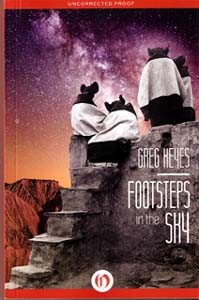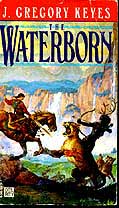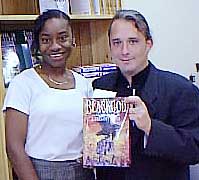Major Works
- Footsteps in the Sky (2015)
- Interstellar: The Official Movie Novelization (2014)
- Dawn of the Planet of the Apes: Firestorm (2014)
- Lord of Souls: An Elder Scrolls Novel (2011)
- The Elder Scrolls: The Infernal City (2009)
- The Hounds of Ash: and other Tales of Fool Wolf (Paperback) (2008)
- The Blackgod: Chosen of the Changeling Book Two (1997)
- The Waterborn: Chosen of the Changeling Book One (1996)
Babylon 5
- Deadly Relations: Bester Ascendant (Babylon 5) (1999)
- Final Reckoning: The Fate of Bester (Babylon 5) (1999)
- Dark Genesis: The Birth of the Psi Corps (Babylon 5) (1998)
Star Wars: The New Jedi Order
- The Final Prophecy (2003)
- Edge of Victory I: Conquest. Star Wars: The New Jedi Order, Book One, (2001)
- Edge of Victory II: Rebirth. Star Wars: The New Jedi Order, Book Two, (2001)
The Age of Unreason
- The Shadows of God: The Age of Unreason, Book Four, (2001)
- Empire of Unreason: The Age of Unreason, Book Three, (2000)
- A Calculus of Angels: The Age of Unreason, Book Two. (1999)
- Newton’s Cannon: The Age of Unreason (1998)
The Kingdoms of Thorn and Bone
- The Born Queen (The Kingdoms of Thorn and Bone, Book 4) 2008
- The Blood Knight (The Kingdoms of Thorn and Bone, Book 3) 2006
- The Charnel Prince (The Kingdoms of Thorn and Bone, Book 2) (2004)
- The Briar King, (The Kingdoms of Thorn and Bone, Book 1) (2003)
Biography of Greg Keyes
by Ashley Rice (SHS) 1999
J. Gregory Keyes, also known as Greg Keyes, was born on April 11, 1963, in Meridian, Mississippi. He entered the literary world of fantasy in August of 1996 with a highly-praised novel called The Waterborn. The inspiration for both The Waterborn and its sequel The Blackgod can be found in Keyes’ fascination with languages, cultures, and history. The seeds for the world of The Waterborn were planted in a world history class that Keyes took as an undergraduate at Mississippi State University. While discussing the need for flood control in civilizations like Egypt and Mesopotamia, Keyes began to formulate a vision of a city on a river that was literally alive. He continued to be plagued by the idea of a river which had a special relationship with “its children.” This vision remained until The Waterborn and The Blackgod were written some twelve years later. In these two novels, Keyes skillfully combines myths, ideas, and beliefs from Egyptian, Native American, and Mesopotamian civilizations. His style creates a world that has familiar ideas but uses those ideas in a unique way.
Keyes was born in Mississippi, but his father’s job took them to a Navajo reservation in Arizona. There at age four, he quickly became bilingual. The time spent at the reservation combined with evenings with his Choctaw relatives telling stories forever left an impression on Keyes. He soon developed a deep interest in languages, myths, legends, and the art of telling stories.
Keyes went to college at Mississippi State University in Starkville, Mississippi, where he earned a B.A. in Anthropology. He and his wife Lanelle Keyes (Nell) moved to Athens, Georgia, where he worked ironing newspapers and as a night guard to support his wife’s pursuit of a metalworking/jewelry degree. She is now a full time faculty member of Savannah College of Art and Design. He also seriously began writing in his spare time because as Greg states, “Ironing newspapers gives you a lot of time to think.”
Greg Keyes is the New York Times-bestselling author of Star Wars, Babylon 5, Elder Scrolls, and Planet of the Apes tie-in novels, as well as the award-winning Age of Unreason fantasy series, and most recently the Interstellar movie novelization.
With his latest publication, Footsteps in the Sky (2015), Keyes has now published twenty-two novels. According to his publisher, Keyes’s newest novel, which apparently is actually his never-before published first novel, tells the story of SandGreyGirl, who “is a descendant of pueblo peoples like the Hopi and Zuni. Her grandparents made the one-way trip to the Fifth World, hoping to return to their way of life and the Kachina spirits that nurtured them. Sand has her doubts, but she longs to believe that the real Kachinas live beyond the stars, and made this world ready for her people. Someone has been seeding planets; nine habitable worlds have been found spanning the galaxies. But no other sign of the aliens was discovered—until now. They’ve returned to the Fifth World, and they do not like what they find.”
Biography of Gregory Keyes
by Draneka Ferguson (SHS) 1999
J. Gregory Keyes is noted for his fantasy epic adventures. Keyes takes his fantasies and make them real world situations. The gods and fictional humans are able to hold the attention of Keyes’ audience. J. Gregory Keyes was born in Meridian, Mississippi. When he was only a small boy, his father took his family to live on an Arizona Navajo reservation where he quickly became bilingual. His early experience in the Navajo culture was the beginning of a lifelong fascination with inquisitions, rituals, myths, and legends. The experience also produced in him an emotional connection, a connection that is now evident in the thirty-two year old author’s first fantasy novel Waterborn.
To Keyes, writing is and will always be a window through which one’ s imagination can be released. Keyes says, “ The written word has been compelling to me since before I could read; my mother used to read to me, but it was when I realized that I myself could see stories in the ink of a book that I wanted to create such stories myself.”
During his college years Keyes wrote the riveting fantasy novel Waterborn. The idea of this story came from a world history class where the class discussion centered on civilizations in Egypt and Mesopotamia. J. Gregory Keyes’s fascination with the world and its beings has enabled him to present two great novels, The Waterborn and The Black God. In conclusion, Keyes’ works of fantasies are pleasurable to audiences that enjoy science fiction. Keyes taught at the University of Georgia (1999) and is pursued a Ph. D in the anthropology of belief systems and mythology. He is now listed on the Savannah College of Art and Design as a researcher of Archaeology, Prehistoric Archaeology, and Military History, with interests in historical archaeology, and violence.
Reviews
A Review of The Waterborn
by Ashley Rice (SHS) 1999
In the fantasy novel The Waterborn by J. Gregory Keyes, the main characters experience conflict at the hands of their gods and themselves. Their heartache and inner conflict is present throughout the book. Through their struggles, they mature and learn to be themselves rather than to conform to society. The two main characters, Perkar and Hezhi are followed separately through most of the novel. Perkar lives with the rest of his family in the pasture lands. The only life he knows is farming and raising cattle. There are gods and goddesses everywhere in his land. Gods dwell in the pasture, forest, rocks, sky, and streams. Perkar falls in love with a beautiful stream goddess and he is saddened to learn that she is in constant pain because a larger more powerful god ” swallows” her. He vows to destroy the god who causes his love pain. His family laughs at his childish daydreams, and they tell him to be a good son and settle down with a wife. He refuses to forget his plans or do his families bidding. The king of his valley makes a journey to bargain with the forest god for more pasture land. Perkar takes advantage of the situation, and steals from this powerful god. In his ignorance,Perkar only thought of himself and his desires. His veil of innocence was soon swept away when his companions suffered greatly because of his foolish actions. His path from a naive child to an adult is not easy. He feels very guilty for his actions. He learns to live with his past, and take responsibility for his actions. He is forced to run from the wrath of the god, and he escapes to the River. The River that has it’s own ideas about Perkar’s destiny.
The other main character, Hezhi is a determined, inquisitive young princess. She begins to question her lifestyle when her favorite cousin mysteriously vanishes. Determined to find him, she starts asking questions. However, unlike most young children, she does not forget her questions, and she is determined to find answers. Her ever faithful guardian and friend, Tsem, disapproves of her quest, but he cannot persuade her to stop her searching. After two years of searching for her lost cousin, her search leads her to the castle’s library. The librarian, Ghan, becomes her reluctant friend, and he aids her to the best of his ability. He gives her knowledge. He teaches her to read the ancient language, and this enables her to read the old books that tell of her families origins, the path of the river, and many other things. As Hezhi’s knowledge grows, so do her questions. She realizes that her family’s tie with the river is much more complex than she could have known, and that the tie which makes her family so powerful also destroys many of her relatives lives. In her innocence, Hezhi makes a wish. A wish that forever changes her life, and the lives around her. Sometimes, a problem in fantasy is that it is hard to understand the world that is being created, and the ideas are too foreign. This is not the case in The Waterborn. Keyes introduces his world very smoothly, so that it is easily understood, slightly familiar, but unmistakably unique.
Keyes uses many literary elements in his writing. Some are very obvious, but others are skillfully blended in so that they are almost invisible. Keyes focuses on the individuals and their inner and outer conflicts. Perkar and Hezhi are forced to grow up and deal with issues that, while are not familiar, we can relate to them. There is a constant struggle within Perkar, and moral issues wage battle in his mind. He feels guilt for many of his actions, and he wishes he could go back and change things. His lack of resolution with the past makes him almost apathetic about the future. Finally, in the middle of his travels, he makes up his mind that he will not give up. His resolution gives him the willpower to keep going when he could easily have died. Hezhi has the inquisitive nature of any child. And like any child that truly wants to know the secrets grown up’s keep, she continues to poke and prod until she finds the answers she seeks. Also, as is often the case, when she finds the answers she so desperately sought, she wishes she could forget the truth. Foreshadowing in The Waterborn is very prominent. Since the two main characters are followed separately through much of the book, the reader keeps waiting for them to meet. So, when Hezhi wishes that someone would ” Send me a hero” (74), the implication that Perkar is her hero is obvious. Also, when Perkar begins thinking about his gods, many paradoxes form from the depths of his mind. “It seemed to him– if there were only one huge god, like the pasture god, but unimaginably bigger- it would be as if there were no gods at all” (105). In a way, this is foreshadowing Hezhi’s beliefs, and how Perkar will have to face different views on a very complex issue. Also, allusions refer to many of the religions today where only one God exists.
The title, The Waterborn, is at first confusing, but it is very appropriate. Waterborn is the name given to the “Royal Blood” of Hezhi’s family because they were originally, literally, born from the water. The world of the Waterborn, although different and foreign, can be easily understood by all.The Waterborn is an excellent book that any avid reader with imagination should thoroughly enjoy.
A Review of The Blackgod
by Draneka Ferguson (SHS) 1999
This book is a sequel to his first novel Waterborn. Keyes, a young author, explains the life of a runaway princess and the gods and humans who help her. This fantasy starts with the princess of Nhol, who is not described in detail until the end when the reader discovers that that she is a young lady who doesn’t know what to believe about life and gods. Perkar, a mentor and keeper of Henzhi, has his own faults and problems with the gods of the Waterborn. Perkar caries a sword that talks to him (it has the voice of the god Harka that warns Perkar of danger). Other important characters are Ghan and Ghe (the human that is supposed to rescue Henzhi from the kidnapper.
The plot of this story takes place mainly at Mang, an Indian reservation where Henzhi is kept by Brother Horse, the chief of the tribe. This is where she faces all of her worst nightmares in the form of gods. The BlackGod is then noticed by Perkaras, an air god. This is the only god that can help Perkar and Henzhi in their struggle with their identities, which brings on conflicts of man vs god, man vs man, man vs self. Perkar has problems accepting Henzhi and another human. Henzhi faces what she wants to call her inner self and doesn’t totally trust anyone that tries to help her.
As the story progresses, a theme is developed, which is that everything on the earth is not always what it seems. Fictional things and people exist and cannot always be trusted. In conclusion, this is an all-around fantasy land story that keeps the reader thinking about who is who. The novel is long, but well worth the reader’s time.
Interview with J. Gregory Keyes (1999)
by Ashley Rice (SHS)
Why does the Blackgod (who seems to be fickle and two-faced) help the main characters?
- He does it for his own reasons, not just because he’s nice.
Did you originally plan for The Waterborn to have a sequel?
- Well, yes and no. I knew when I was writing The Waterborn that it was getting very long, like 1000 pages. But I hadn’t sold it yet, so I found a comfortable place to stop. When I sold The Waterborn, they asked if I would write a sequel so, of course, I said yes.
Are you working on anything new?
- Yes. I am working on a trilogy unrelated to The Waterborn.
About how long does it take to write a book?
- Well, I wrote The Waterborn in four months. I was in school, so I basically had a summer to write. I was writing nine hours a day; but now that I am out of school, I can write full time.
How did you make up the names and languages?
- Well, that is basically what I did; I make up languages.
Did you model them after any certain languages?
- Actually, yes. The languages are real similar to Navajo.
What type of books do you mostly read?
- Well, I do a lot of research, especially for my new books. I have to stop writing all the time to go find out exactly what this person would wear, and what the fashions were. I am having to do more research than I thought I would.
What are the new books about?
- Well, it is an alternate history. What if, instead of discovering science, Newton had discovered something more like…magic.
Tell me about this Indian sport involving ” heavy sticks and few rules.”
- Well, it is similar to lacrosse , but instead of having one large stick, you have two smaller ones that you hold in each hand. There is a ball about the size of a golf ball. There are almost no rules. You don’t wear any padding or shoes. It gets very bloody.
Related Websites
- Review of Newton’s Cannon by Larry Woods
- Amazon reviews of Keyes’ books.
- Fantasy Literature’s bio page on Greg Keyes contains much info about his books.
- Interview with Greg Keyes (2008)
- Take Five With Greg Keyes, Author, ‘Lord of Souls: An Elder Scrolls Novel’ (2011)






